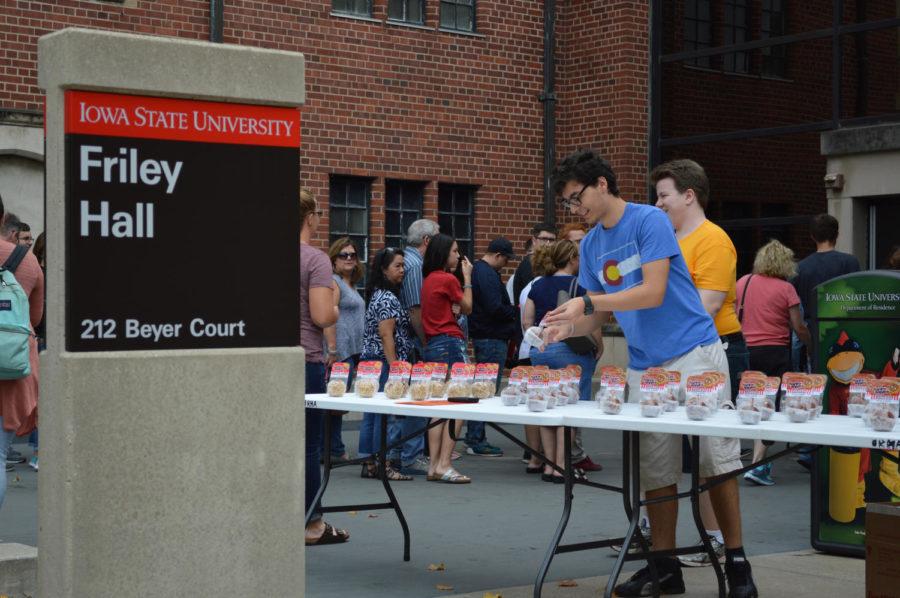A history of Iowa State’s residence halls
January 18, 2017
Geoffrey Hall, the newest residence hall on campus, opened Jan. 18 and is the first residence hall to be built since Martin Hall in 2004.
A lot has changed on campus over the span of 13 years, including the need for new residence halls.
Here’s a history of campus residence halls, as found in “The First 100 Years of Residential Housing at Iowa State University, 1868-1968” and the University Archives.
Richardson Court
1914: Lyon Hall was built after concerns were raised about the crowded living conditions of Margaret Hall. Lyon Hall closed during the Great Depression due to falling enrollment. In the summer of 1943, Lyon Hall was used by male students when the Navy took over the men’s residence halls. Female students moved back into Lyon in the fall of 1943.
1916: Barton and Freeman halls were built. Originally named South Hall, Barton was named after Clara Barton. Freeman Hall was originally named East Hall, but was renamed in 1928 after Alice Freeman, president of Wellesley College in Massachusetts. Freeman Hall was the first women’s-only dormitory built after Margaret Hall, where LeBaron Hall now stands.
1922: Birch Hall was built as part of the Carrie Lane Court complex with Welch and Roberts halls to accommodate the increasing number of female students. Today, Birch, Welch and Roberts halls are all-male dormitories.
1929: Welch Hall was built next to Birch Hall as part of the complex to accommodate female students.
1936: Roberts Hall was built and became the final hall built in the complex with Birch and Welch halls.
1938: Oak Hall and Elm Hall were built. These two halls are connected to each other and have been connected since their construction in 1938.
1957: Linden Hall was built, becoming the last Richardson Court hall to be built until 1967, when Maple and Willow halls were built.
1967: Maple and Willow halls were built as all-female halls.
1971: Larch Hall was built as an all-male residence hall. It is the last hall to be built before the Department of Residence began implementing its “Master Plan” for constructing and remodeling residence halls and building Union Drive Suite No. 1, which was later renamed Eaton Hall.
South Campus
1963: Buchanan Hall was constructed as a residence hall for international students. The lot was purchased in 1879 by Iowa State President Adonijah Welch to be used for a family home.In 1898, the heirs to the Welch estate sold the house to veterinary science professor Millikan Stalker, who then willed the house to his sister. The sister proposed the property go back to the college.In 1928, the house, called The Gables, became International House, a residence hall for male international students. The house was razed in 1963 to make way for Buchanan Hall.
1967: Wallace Hall was built as part of the Towers Residence Association, along with Knapp and Storms halls, which were imploded in 2005. Wallace Hall was named for Henry A. Wallace, an Iowa State graduate who served as U.S. secretary of agriculture and vice president of the United States during Franklin Delano Roosevelt’s second term in office.
1969: Wilson Hall was built as the final residence hall in the Towers Residence Association. Wilson Hall was named after Iowa State dean of agriculture James Wilson.
Union Drive
1927: Friley Hall was built. Originally called Hughes Hall, Friley has undergone six additions spanning 24 years and consists of six units. Friley Hall housed “V-12” students during World War II for military training.
1957: Originally an all-men’s residence hall, Helser Hall was named after junior college dean Maurice D. Helser.
2003: Eaton Hall was built. Originally named Union Drive Suite No. 1, Eaton Hall was part of the Union Drive Suite complex consisting of Eaton and Martin halls.
2004: Martin Hall was built as the final hall in the Union Drive suite complex. Martin Hall was named after Archie and Nancy Martin, who provided accommodations for African-American students attending Iowa State in the 1930s and 1940s.
















